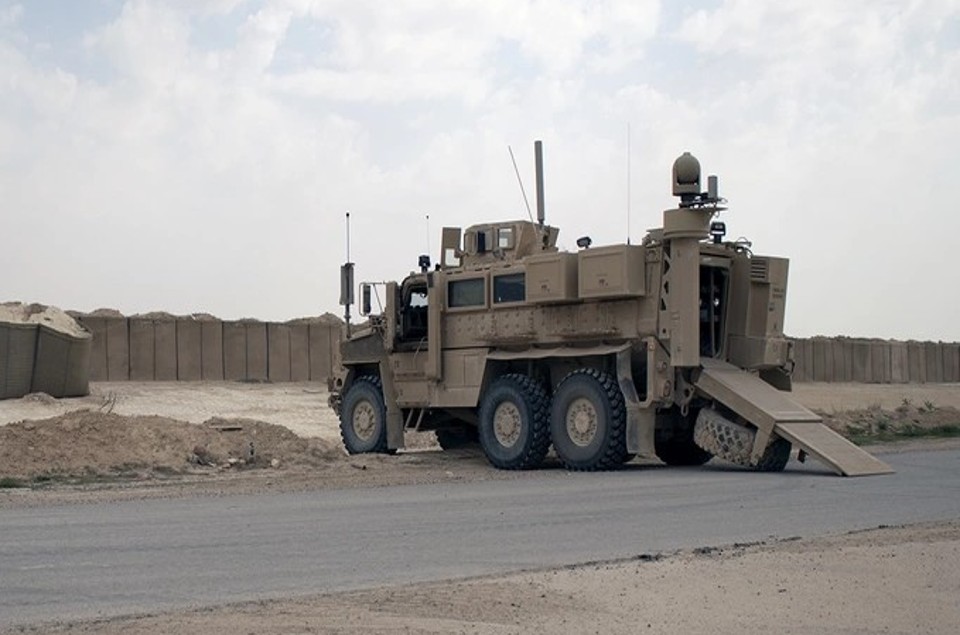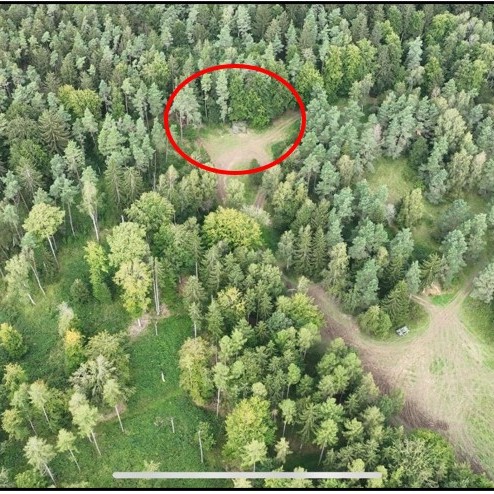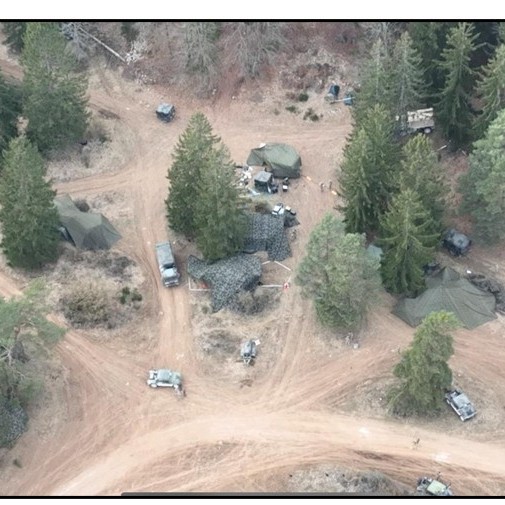Defeating the Drone – From JMRC’s “Skynet Platoon”

Are you a Soldier looking to avoid being ripped apart by a $7 mass produced drone? Then this article is for you. The Joint Multinational Training Center (JMRC) is the premier innovation and modernization training facility in the world, with unique terrain for employing and reacting to UAS in a large-scale combat operations environment. As drones continue to revolutionize warfare, formations of all sizes and functions must adapt their tactics, techniques, and procedures to win the UAS and Counter-UAS (C-UAS) fight. At JMRC in Hohenfels Germany, 1-4 Infantry Regiment’s Multi-Domain Threat Platoon, callsign “Skynet,” has become a feared enemy, hunting and striking unsuspecting units from above. The lethal team of OPFOR drone operators has years of experience challenging Blue Forces (BLUFOR) and continues to evolve through cooperation with Ukrainian Brigades that bring frontline combat experience. Skynet effectively employs a fleet of quadcopters, FPV one-way strike drones, drone swarms, and fixed-wing UAS to locate and destroy BLUFOR every rotation. This article focuses on helping company-level junior officers and NCOs remain alive and lethal while overcoming the UAS threat. There are three critical areas to employ UAS and C-UAS TTPs: Cover and Concealment, UAS employment across all operations, and response to UAS.
- Cover and Concealment from UAS
If you can be seen, you can be killed. UAS enables a vastly increased level of lethality to the enemy reconnaissance-strike complex. Cover and Concealment is the core C-UAS tactical principle and is increasingly critical. At JMRC, Skynet employs UAS for persistent surveillance and on-call targeting against BLUFOR. Once Skynet identifies a target, they engage units with indirect fire or strike drones. In a recent rotation, Skynet executed 34 call for fire missions on BLUFOR, the majority of these missions were against troops or vehicles in the open.
What you can do: Don’t be seen. To win the fight and maintain combat effectiveness, platoons must remain concealed, avoid open linear danger areas, and maneuver off predictable avenues of approach. Battle positions and vehicles need to be well camouflaged from above and include thermal masking camouflage nets to avoid UAS detection.
The reconnaissance-strike-complex or kill chain you are trying to conceal yourself from is the combination of surveillance capabilities (UAS, Satellites, EW detection, etc) with artillery and other strike assets to find and destroy targets as far forward as possible. This is a coordinated approach to both gathering information and delivering fire, emphasizing speed and efficiency. This kill chain has been seen in action with devastating effect on the frontlines of the war in Ukraine.
Ukrainian Forces training in Germany shared essential Cover and Concealment TTPs with Skynet that every junior officer should know and incorporate into planning their operations:
- Noise, Light, and Litter Discipline. Minimize your visual signature.
- UAS are more lethal at night: Thermal cameras are increasingly common, and heat signatures are easier to detect than camouflaged fighting positions. As the ground cools at night, you and your equipment stand out. Be especially wary of vehicle exhaust and employ thermal camouflage nets.
- Conceal freshly dug dirt: After digging a fighting position, cover any new dirt with brush, displaced earth is a dead giveaway for your perfectly concealed fighting position.
Junior officers must understand how to select fighting positions for their platoons and C2 nodes for their company. British Observer Coach Trainers shared the CADEL acronym on how they select and establish command post and fighting positions:
- Concealment: Hiding the position from enemy observation.
- All-round defense: Ensuring the position can be defended from attacks from any direction, including above.
- Dispersal: Spreading out personnel and equipment to minimize casualties from enemy direct, indirect, or UAS employed fire.
- Ease of access/egress: Being able to move into and out of the position quickly and easily, for resupply, reinforcement, or withdrawal if identified by enemy UAS.
Location (in relation to the battlespace): Choosing a position that provides good observation, fields of fire, and supports the overall mission.
Skynet in Action: During a recent rotation, a 1-4 IN Skynet recon team utilized UAS to locate and destroy seven BLUFOR armored vehicles with dropped munitions in exposed open tank hatches. Despite extensive camouflage on the front and sides of the vehicles, the armor was easily detectable and destroyed from above, emphasizing the need for improved cover and concealment against UAS detection.
What right looks like:
BDE TAC that was mobile, light, and barely noticeable in the top center of the photo. Positioned under thermal camouflage and support vehicles under thermal camo in the tree line. The high angle of the trees makes it undetectable from most directions.
What wrong looks like:
BN Main Command post with multiple tents and vehicles exposed and outside of the tree line. It proved easily detectable by UAS. One UAS operator conducted a drone strike, resulting in two casualties. As the unit began providing medical care in the open, the same operator executed a call for fire mission resulting in a MASCAL. Always practice dispersion and concealment while establishing C2 nodes or fighting positions to avoid detection from UAS or satellite.
- Employment of UAS in all Operations.
UAS significantly enhances situational awareness and operational flexibility during BLUFOR maneuvers. UAS must be integrated into offensive maneuvers. A platoon’s operations benefit from UAS-directed reconnaissance, allowing units to verify enemy positions, adapt their plans to the terrain, coordinate supporting fires before and during engagements, and facilitate commanders’ greater command and control. Extending the range of what a maneuver platoon can see through a small aerial platform not only increases the lethality of the platoon but also contributes to the common operating picture if the information is passed up the appropriate channels in a timely manner. By integrating company medium-range recon UAS and BN long-range recon UAS, the platoon should have a thorough understanding of METT-C considerations prior to any mission.
UAS use is not limited to maneuver forces and increases the combat effectiveness of every formation. In convoy operations, UAS overwatch ensures routes are clear of obstacles and detects ambushes, providing early warning and improving convoy survival rates. For base defense or security, a single UAS system flown intermittently, augmenting security, is significantly more effective than a handful of soldiers in traditional security positions. Once set in a fighting position or C2 node, launch a UAS and view yourself. What is exposed? What camo netting needs to be adjusted? Use the UAS thermals as well. Are your generators or vehicle engines an obvious giveaway? Where can you launch UAS and remain undetected? If you can see yourself, the enemy can find you and strike. Junior officers must be proficient in UAS operations and call for fire missions. Especially officers in sustainment or protection warfighting function units without high casualty-producing weapons. If attacked, the ability to quickly launch or request the launch of a UAS, locate the enemy and execute an accurate call for fire is a lifesaving ability for junior officers. If you don’t already, add a call for fire to your battle book.
Skynet in Action: During the defense of “Kittensee” in a recent rotation, Skynet used UAS to locate and execute 11 call for fire missions on approaching BLUFOR. Junior officers should consider incorporating UAS into all operations, gaining and maintaining contact with the enemy via unmanned systems.
OPFOR Footage
Static BLUFOR armored vehicle detectable and unprotected from above. Skynet launched sorties of UAS equipped with dropped munitions, targeting the open hatches and destroying the vehicles.
- React to UAS: Battle Drills for Breaking Contact and Drone Neutralization
Reacting to enemy UAS requires rapid, rehearsed responses that include battle drills for breaking contact and neutralizing drones. In Ukraine, the sensor-to-shooter (IDF) kill chain has been shortened to 1-3 minutes. If enemy UAS are spotted or detected, immediate action should include engaging with weapons, breaking visual or electronic contact, obscuring positions, and relocating to avoid further targeting. Effective responses to UAS can prevent the enemy from exploiting a platoon’s position, reducing the risk of follow-on indirect fire or ambush. Your platoon must be proficient in reacting to enemy UAS to remain lethal.
The following from ATP 3-01.81 Counter-Unmanned Aircraft Systems (C-UAS) breaks down the react to UAS battle drill:
- Detect: Employ frequency monitors for early warning. Leverage every Soldier as a sensor; UAS are often audible/visible within 300 feet. Constant vigilance is key.
- Warning: Upon detection, soldiers must alert the formation. Ensure your formation has SALUTE reports and can quickly report unidentified UAS.
- Track/Identify: Do not break cover or concealment. Train your soldiers not to run or move vehicles, you will draw the operator’s attention. Track the UAS. Treat every UAS as hostile until confirmed friendly.
- Decide: Make the decision if you are going to engage. Good concealment, UAS at high altitude, and inadequate weapons may favor non-engagement. If compromised, engage with all available assets (small arms, crew-served, EW). Consider your weapon limitations. Drone busters have limited jamming capability. Leadership competence and decision making is crucial in this step.
- Defeat, Engage and Exploit: Observe jammed UAS flight path for potential return-to-launch-point targeting opportunities. Exploit downed UAS per unit SOP, and treat downed UAS as UXO.
- Break contact: While not covered in ATP 3-01.81, breaking contact is often the best option once your formation is detected. Many UAS have limited battery life. Breaking visual line of site with the UAS or rapidly displacing decreases the likelihood of an effective call for fire on your position. If you defeat a drone, understand the operator knows your location and can still execute a call for fire.
Skynet in Action: During one engagement, a 1-4 IN platoon quickly deployed smoke to obscure themselves when enemy UAS was detected, allowing them to break contact successfully. Given the multiple repetitions during six training center rotations a year, 1-4 IN is skilled at the react to UAS Battle Drill; on the modern battlefield, all soldiers must be proficient at this 10 level task. Incorporating drone busters or more advanced C-UAS systems to disrupt enemy surveillance in these moments could further protect the formation from subsequent attacks.
OPFOR Footage
BLUFOR Soldiers conduct a brief in the open. Skynet conducted a call for fire on the element after observation, resulting in seven casualties.
Conclusion
Understanding and adapting to UAS integration is key to mission success. Soldiers, NCOs, and officers must incorporate these UAS-specific adaptations into their tactical planning, training on cover and concealment against UAS, employing UAS for maneuver support, and mastering rapid response drills to counter enemy drones. Through these practices, junior officers can help create more resilient and adaptable units capable of overcoming any adversary in a modern combat environment, including those enhanced by UAS technology. Keep your formation alive and lethal: do not be seen and employ your UAS to find and strike the enemy.
Authors Biography
CPT Joshua Cox is a UH-60 Helicopter Pilot and Observer/Coach Trainer with the Falcon Team at the Joint Multinational Readiness Center (JMRC). He supports the JMRC UAS Program, focusing on the integration of Unmanned Aircraft Systems (UAS), manned aviation, and fire support operations within a confined airspace.
SSG Samuel Gordon is the NCOIC of the 1-4 Infantry Regiment’s Skynet UAS Detachment. A certified UAS Master Trainer, he possesses extensive experience in the construction and operation of First-Person View (FPV) UAS. SSG Gordon has also facilitated UAS training for multiple Ukrainian units training in Germany.
SSG Eric Navarro is a Section Sergeant within the Skynet UAS Detachment. He routinely leads small teams of UAS operators and special purpose forces in conducting reconnaissance, attack, and swarm operations to challenge the Rotation Training Unit during rotations.
Related Posts

3 Deployments Before Captain: Reflections From Down Range
Deployments challenge junior officers beyond their primary duties, often demanding adaptability, wellness management, proactive leadership, and moral integrity maintenance.

Check the Box or Check Your Compass
MSG Albert Keever explains how ethical fading erodes integrity and offers tools for junior leaders to strengthen ethical decision-making.

Leadership at Zero Meters: Combatives for Building Lethal Teams
U.S forces close with and destroy the enemy. But how close? One kilometer, 300 meters, hand grenade range? How about close enough to hear your enemy’s last words?




